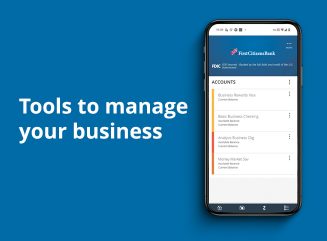
Digital banking for business
Seamlessly access all of your accounts from one place with First Citizens Digital Banking for business.
Having a family changes the way you make decisions—suddenly, you're thinking not just about your own health, safety and future but also those of your partner or your kids.

This shift should happen in the way you make investments, too. For example, you may be less likely to accept high levels of risk. You may feel compelled to invest in assets you're confident will generate high returns so you can pay for your family's expenses, from your spouse's retirement to higher education for your kids.
Making a few key considerations will help you plan your family investments, providing more peace of mind that you're headed toward your goals for both yourself and for your loved ones.
Making family investments is more than teaming up with a spouse to invest together. It's about creating a shared understanding of financial goals and both short- and long-term plans so your whole family is on the same financial path.
Today's families take many different shapes and sizes. More people mean more ideas and needs to add to the financial mix. No matter your needs, key areas you might consider adjusting are your savings for retirement, education and your emergency fund for your growing family.
It's not uncommon for couples to have different ideas of what age they'll retire and how much they need to save for a comfortable retirement. This is why it's important to have a conversation about individual and shared family goals.
To start this conversation, ask your partner:
These questions will help show if you and your partner have any differences of opinion, so you can address solutions now. They'll also help you get a clear understanding of your retirement assets and how much you'll need to save to meet your shared goals.
When it comes to risk tolerance, keep in mind that as you approach retirement age, you'll likely want to preserve the wealth you've accumulated. This may mean shifting from higher-risk investments like stocks to lower-risk options such as bonds and low-volatility mutual funds.
Whatever accounts are available to you to save for retirement, including personal and employer-sponsored plans, consider maxing out your annual contributions to these accounts to get the best returns. You'll also want to keep track of funds in employer plans when you change jobs and potentially roll those funds over into an IRA or your new 401(K) plan.
Whether you already have children or planning to have them, it's never too early to start saving for costs associated with education. Educational savings accounts are family investments you can't afford to overlook.
529 plans let parents and relatives save for education and tuition expenses for K-12 education and college. If you want to open a 529 plan before a child is born, you can open one in your name and start saving right away. Once your child is born, you can change the beneficiary on the account to your child and keep the savings going. Be sure to check with your tax or investment advisor on the annual contribution limits specific to your state.
Coverdell Educational Savings Accounts are also worth considering. Contributions max out at $2,000 per year and no contributions can be made after the child's 18th birthday.
You can make contributions to both a Coverdell ESA and a 529 plan. Contributions to one don't limit contributions you can make to the other.
Retirement and education savings only scratch the surface of how your investment strategy might change as your family grows. Here are other areas you might revisit as your family changes through the years:
When making family investments, the most important thing to consider is that it's not all about you anymore. While some of these conversations might feel difficult to start, they'll pave the road for easier times when you know you're working toward shared goals with a shared understanding.
Email Us
Please select the option that best matches your needs.
Customers with account-related questions who aren't enrolled in Digital Banking or who would prefer to talk with someone can call us directly.